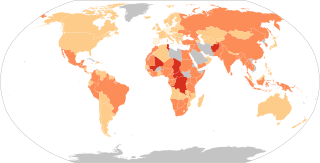Sexual assault is an act in which one intentionally sexually touches another person without that person's consent, or coerces or physically forces a person to engage in a sexual act against their will. It is a form of sexual violence that includes child sexual abuse, groping, rape, drug facilitated sexual assault, and the torture of the person in a sexual manner.

Juvenile delinquency, also known as juvenile offending, is the act of participating in unlawful behavior as a minor or individual younger than the statutory age of majority. These acts would otherwise be considered crimes if the individuals committing them were older. The term delinquent usually refers to juvenile delinquency, and is also generalised to refer to a young person who behaves an unacceptable way.
A rape kit or rape test kit is a package of items used by medical, police or other personnel for gathering and preserving physical evidence following an instance or allegation of sexual assault. The evidence collected from the victim can aid the criminal rape investigation and the prosecution of a suspected assailant. DNA evidence can have tremendous utility for sexual assault investigations and prosecution by identifying offenders, revealing serial offenders through DNA matches across cases, and exonerating those who have been wrongly accused.
A sex offender is a person who has committed a sex crime. What constitutes a sex crime differs by culture and legal jurisdiction. The majority of convicted sex offenders have convictions for crimes of a sexual nature; however, some sex offenders have simply violated a law contained in a sexual category. Some of the serious crimes which usually result in a mandatory sex-offender classification are sexual assault, statutory rape, bestiality, child sexual abuse, incest, rape, and sexual imposition.
Rape can be categorized in different ways: for example, by reference to the situation in which it occurs, by the identity or characteristics of the victim, and by the identity or characteristics of the perpetrator. These categories are referred to as types of rape. The types described below are not mutually exclusive: a given rape can fit into multiple categories, by for example being both a prison rape and a gang rape, or both a custodial rape and the rape of a child.
Delroy Easton Grant is a Jamaican-born British convicted serial rapist who carried out a series of offences of burglary, rape and sexual assault between October 1992 and May 2009 in the South East London area of England. Grant, also known as the Minstead Rapist and latterly the Night Stalker, is thought to have been active since 1990. He had a distinctive modus operandi, preying primarily on elderly women who lived alone. He is suspected of over 100 offences from 1990 to 2009.

Rape is a type of sexual assault involving sexual intercourse or other forms of sexual penetration carried out against a person without their consent. The act may be carried out by physical force, coercion, abuse of authority, or against a person who is incapable of giving valid consent, such as one who is unconscious, incapacitated, has an intellectual disability, or is below the legal age of consent. The term rape is sometimes used interchangeably with the term sexual assault.
Antoni Imiela was a German-born convicted serial rapist who grew up in County Durham, England. He was found guilty of the rape of nine women and girls, and the indecent assault, and attempted rape, of a 10-year-old girl whom he repeatedly punched and throttled. The crimes took place in Surrey, Kent, Berkshire, London, Hertfordshire and Birmingham, and the press dubbed the offender the M25 Rapist after the M25 motorway that passes in the vicinity of all those areas except Birmingham. He died in HM Prison Wakefield on 8 March 2018.
Kym Loren Worthy is an American lawyer and politician serving as the prosecutor of Wayne County, Michigan since 2004. A member of the Democratic Party, she is the first African-American woman to serve as a county prosecutor in Michigan. She is most noted for prosecuting then-Detroit Mayor Kwame Kilpatrick at the beginning of March 2008.
Sexual violence refers to a range of completed or attempted sexual acts in which the affected party does not or is unable to consent. Theories on the causes of sexual violence are numerous and have come out of many different disciplines, such as women's studies, public health, and criminal justice. Proposed causes include military conquest, socioeconomics, anger, power, sadism, traits, ethical standards, laws, and evolutionary pressures. Most of the research on the causes of sexual violence has focused on male offenders.

The Debbie Smith Act of 2004 provides United States federal government grants to eligible states and units of local government to conduct DNA analyses of backlogged DNA samples collected from victims of crimes and criminal offenders. The Act expands the Combined DNA Index System (CODIS) and provides legal assistance to survivors of dating violence. Named after sexual assault survivor Debbie Smith, the Act was passed by the 108th Congress as part of larger legislation, the Justice for All Act of 2004, and signed into law by President George W. Bush on October 30, 2004. The Act amended the DNA Analysis Backlog Elimination Act of 2000, the DNA Identification Act of 1994, the Violence Against Women Act of 2000, and the Uniform Code of Military Justice. The Act was reauthorized in 2008, extending the availability of DNA backlog reduction program grants, DNA evidence training and education program grants, and sexual assault forensic exam program grants through fiscal year 2014.
John Derek Radford is a British convicted serial sex offender, known as the Black Cab Rapist. Worboys was convicted in 2009 for attacks on 12 women, committed between 2007 and 2008. In 2019, he was convicted for attacks on four more women, the earliest of which took place in 2000. Police say he may have had more than 100 victims.
David Lisak is an American clinical psychologist. He received his PhD from Duke University, and is a retired associate professor of psychology at the University of Massachusetts Boston. Lisak's research focuses on "the causes and consequences of interpersonal violence...motives and behaviors of rapists and murderers, the impact of childhood abuse on adult men, and relationship between child abuse and later violence".

The 'Teardrop' rapist is a moniker for an unidentified rapist responsible for 35 sexual assaults on women, including minors, in Los Angeles, California. The assaults began in 1996 and continued through 2012. He is believed to be a Hispanic male with a light complexion, and received his nickname from at least one teardrop tattoo under his eye.
Studies have been made of the "hunting patterns" of serial offenders, mainly serial killers and those committing repeated sex crimes. By hunting patterns are meant the interaction of time, space, and activity of a serial offender's criminal behavior. The attempt is made to ascribe rational motives to the offender's choice of places and times; investigators may invoke routine activity theory and rational choice theory in relation to the location of crimes.
There have been many theories set forth by researchers regarding the various types of rapists.
After a sexual assault or rape, victims are often subjected to scrutiny and, in some cases, mistreatment. Victims undergo medical examinations and are interviewed by police. If there is a criminal trial, victims suffer a loss of privacy, and their credibility may be challenged. Victims may also become the target of slut-shaming, abuse, social stigmatization, sexual slurs and cyberbullying. These factors, contributing to a rape culture, are among some of the reasons that may contribute up to 80% of all rapes going unreported in the U.S, according to a 2016 study done by the U.S. Department of Justice.
Phillip A. Pizzo, known as The Mall Rapist, is an American serial rapist who committed numerous assaults against women and girls in the Greater Boston area between 1983 and 1984. In November 1984, Pizzo was convicted of kidnapping and raping seven, and received 11 life imprisonment terms with a chance of parole. He later confessed to having raped 20 women. Pizzo's crimes caused a moral panic, due to which any girl or woman was advised to refrain from visiting malls or shopping centers unaccompanied.

A juvenile sex crime is defined as a legally proscribed sexual crime committed without consent by a minor under the age of 18. The act involves coercion, manipulation, a power imbalance between the perpetrator and victim, and threats of violence. The sexual offenses that fall under juvenile sex crimes range from non-contact to penetration. The severity of the sexual assault in the crime committed is often the amount of trauma and/or injuries the victim has suffered. Typically within these crimes, female children are the majority demographic of those targeted and the majority of offenders are male. Juvenile sex offenders are different than adult sex offenders in a few ways, as captured by National Incident Based Reporting System: they are more likely to be committed in school, offend in groups and against acquaintances, target young children as victims, and to have a male victim, whereas they are less likely than their adult counterpart to commit rape.

Bala Kuppusamy, a Singaporean citizen, was a convicted robber and serial rapist who had committed various offences of rape, robbery and molestation from 1985 to 2008. His first offence of raping and robbing a 19-year-old woman in 1985 led to him being sentenced to 11 years' jail and 28 strokes of the cane, and his second conviction for sexually assaulting two students and four robberies led to him sentenced to 23 years' jail and 24 strokes of the cane.





